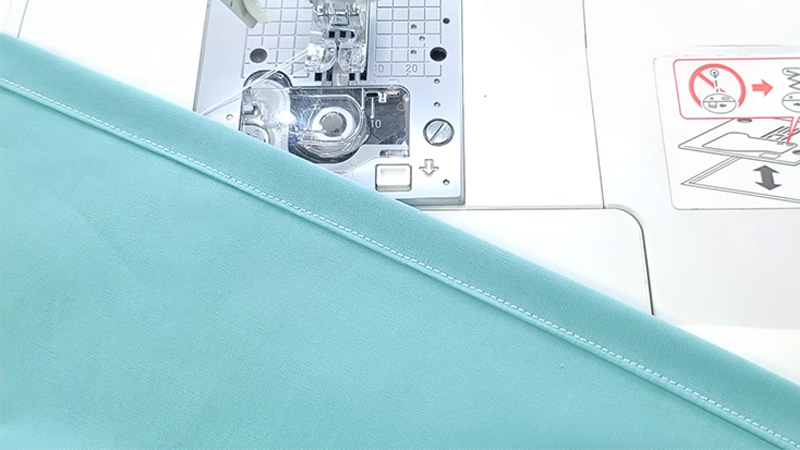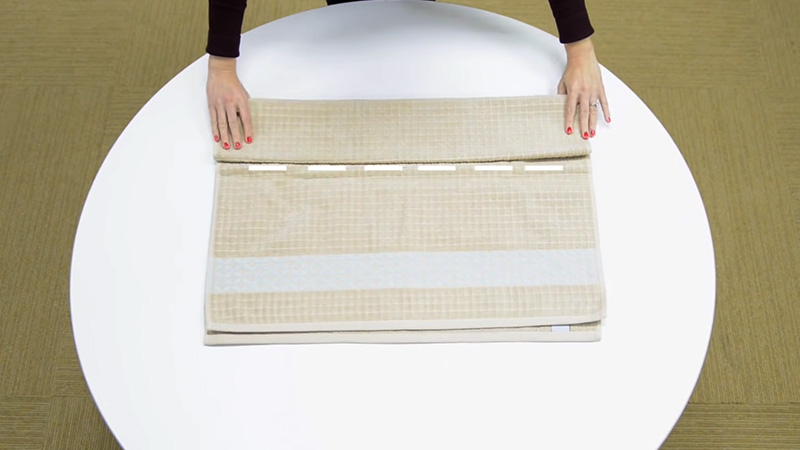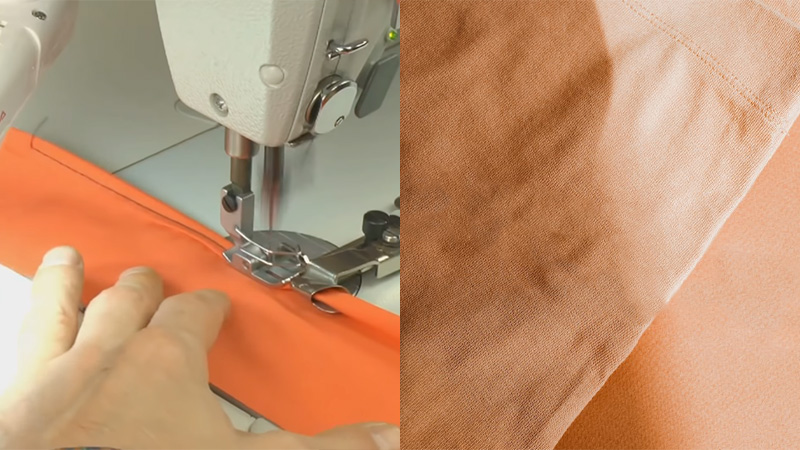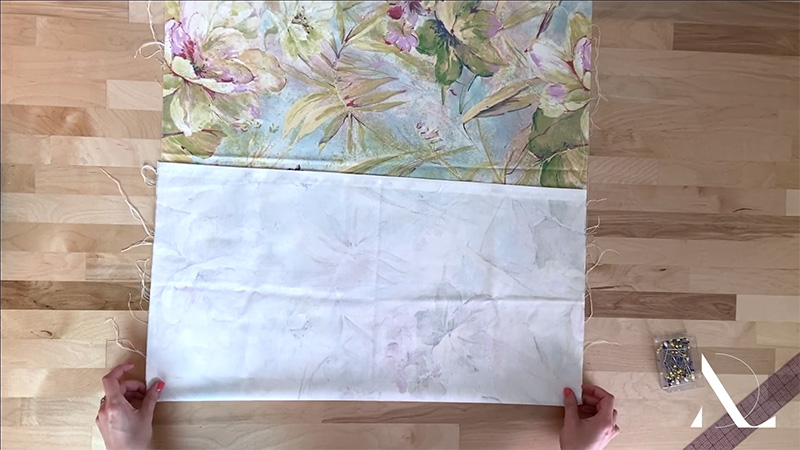In the intricate world of sewing, precision, and attention to detail are paramount. One fundamental technique that sewists rely on is the “lengthwise fold.”
This essential maneuver involves folding fabric along its lengthwise grain, ensuring that the selvage edge, which runs parallel to the warp threads, serves as a guiding reference point.
This seemingly simple act holds immense significance, as it determines the fabric’s stability, shape, and overall outcome of a sewing project.
Whether you’re crafting a classic garment or a unique textile creation, understanding the art of the lengthwise fold is a foundational skill that can elevate your sewing prowess and help you achieve professional results.

What Is a Lengthwise Fold in Sewing?
A lengthwise fold in sewing, often referred to as a “fold along the grain” or simply “fold,” is a fundamental technique used in sewing and fabric manipulation.
It involves folding a piece of fabric along its lengthwise or selvage edge, which is the edge of the fabric that runs parallel to the warp threads.
Understanding and correctly using lengthwise folds is essential for creating symmetrical and well-balanced garments and projects.
Here are some key points to consider when working with lengthwise folds in sewing:
Identifying the Lengthwise Edge
Fabrics have two main edges – the selvage edge and the cut edge.
The selvage edge is the tightly woven edge of the fabric, often with a different texture or appearance than the rest of the fabric.
This is the lengthwise edge. The cut edge is created when the fabric is trimmed or cut to the desired length.
Importance of the Lengthwise Grain
The lengthwise grain is the most stable and least stretchy direction of the fabric.
When you fold the fabric along this grain, you ensure that your garment or project retains its shape and doesn’t stretch out of proportion.
It’s especially crucial for items like skirts, pants, and dresses.
Pattern Placement
When cutting out pattern pieces for your sewing project, it’s essential to align the pattern pieces with the lengthwise grain whenever the pattern instructs you to do so.
This ensures that the design and drape of the finished garment or item will be as intended by the pattern designer.
Preventing Warping
Folding fabric along the lengthwise grain can help prevent warping or distortion in your projects over time.
Fabrics tend to stretch more along the crosswise grain (from selvage to cut edge) and diagonally (bias), so using the lengthwise fold as a reference point helps maintain the fabric’s stability.
Bias vs. Crosswise Fold
It’s important to note that there are other types of folds, such as the crosswise fold (across the width of the fabric) and the bias fold (at a 45-degree angle to the selvage edge).
These folds are used for specific purposes, like creating bias tape or working with stretch fabrics. Lengthwise folds are primarily used for maintaining grain alignment and stability.
How Do You Make a Lengthwise Fold?

Making a lengthwise fold in sewing is a simple process.
Follow these steps to create a lengthwise fold in your fabric:
Prepare Your Fabric
Begin by laying your fabric flat on a clean and smooth surface. Make sure it is free from wrinkles and any debris.
Identify the Lengthwise Grain
Locate the selvage edge of the fabric, which runs parallel to the warp threads. The selvage edge is often more tightly woven and may have a different appearance than the rest of the fabric.
This edge is your reference for creating a lengthwise fold.
Fold the Fabric
To create a lengthwise fold, take one end of the fabric (either the selvage edge or the cut edge) and bring it over to meet the other end, aligning it along the lengthwise grain.
Ensure that the selvage edges are perfectly aligned, and the fabric is smooth and flat between the two ends.
Press the Fold
To set the fold in place and make it more defined, use a hot iron with steam to press along the folded edge.
Apply even pressure and move the iron slowly to avoid creating wrinkles or uneven folds.
If your fabric is sensitive to heat or steam, use a pressing cloth or adjust the iron settings accordingly.
Check Alignment:
After pressing, double-check that the selvage edges are still perfectly aligned and that the fold runs straight along the lengthwise grain.
Secure with Pins or Weights
If your project requires the fabric to stay in this folded position temporarily, you can secure it with sewing pins or fabric weights to prevent it from shifting while you work on your pattern cutting or sewing.
Cut or Sew Along the Fold
Depending on your project, you may need to cut pattern pieces or stitch along the lengthwise fold.
Always follow your sewing pattern’s instructions for precise placement and usage of the fold.
Difference Between Lengthwise and Crosswise Fabric

Lengthwise and crosswise fabrics refer to the two main grain directions in woven fabrics, and they have distinct characteristics and purposes in sewing and garment construction.
Here’s a clear differentiation between lengthwise and crosswise fabric:
Lengthwise Fabric
- Grain Direction: Lengthwise fabric runs parallel to the selvage edge, which is the tightly woven edge of the fabric that follows the warp threads during weaving.
- Characteristics: Lengthwise grain is the most stable and least stretchy direction of the fabric. It typically has minimal give or stretch and offers structural stability to the fabric. Garments or items cut along the lengthwise grain tend to maintain their shape and structure well.
- Common Uses: Lengthwise fabric is commonly used for vertical elements in garments, such as center front and back seams, pleats, and straight hems. It is often used for creating the main body of garments like skirts, pants, and dresses to ensure they retain their intended shape and drape.
- Pattern Placement: Many sewing patterns instruct you to align pattern pieces with the lengthwise grain for proper fit and fabric stability.
Crosswise Fabric
- Grain Direction: Crosswise fabric runs perpendicular to the selvage edge, stretching from selvage to selvage, across the width of the fabric.
- Characteristics: The crosswise grain has more stretch and give compared to the lengthwise grain. : It is ideal for creating parts of garments that require flexibility, such as waistbands, cuffs, and sleeve hems.: Fabrics cut on the crosswise grain may have a different drape and feel compared to those cut on the lengthwise grain.
- Common Uses: Crosswise fabric is often used for elements that need to accommodate movement or body contours. It is frequently used for details like bias tape, neckbands, and bindings due to its stretchiness.
- Pattern Placement: Some sewing patterns may specifically instruct you to cut certain pieces on the crosswise grain to achieve a particular design, fit, or stretch requirement.
Effective Tips for Making a Good Lengthwise Fold

Creating a precise and well-executed lengthwise fold in sewing is crucial for maintaining fabric stability and grain alignment.
Here are some effective tips for making a good lengthwise fold:
Prepare Your Workspace
Start with a clean, flat, and spacious work surface, like a cutting mat or a dedicated sewing table.
Ensure adequate lighting to clearly see the fabric’s selvage edge and any markings.
Smooth and Straighten the Fabric
Lay the fabric flat, removing any wrinkles, folds, or creases. Gently tug on the fabric along the selvage edge to straighten it and eliminate minor distortions.
Use the Right Tools
Employ a clear, gridded ruler or quilting ruler to check that the fold is straight and parallel to the selvage edge.
A rotary cutter and cutting mat can help you achieve precise cuts along the folded edge.
Steam and Press
Use a steam iron to press the fold line. Steam helps set the fold and make it more defined.
Press along the fold slowly and evenly, applying firm but gentle pressure. Ensure the fold is crisp and well-defined.
Measure and Double-Check
Measure from the fold to the selvage edge at multiple points along the length to ensure consistency. Adjust as needed to maintain a uniform distance.
Secure the Fold
If your project requires the fabric to stay folded, use sewing pins or fabric weights to prevent shifting while cutting or sewing.
Cut and Sew with Care
When cutting pattern pieces or stitching along the fold, follow your pattern instructions precisely.
If cutting multiple fabric layers, ensure all layers are aligned and cut accurately to avoid irregularities.
Maintain Grain Alignment
Be mindful of grain alignment throughout your project, especially when matching seams or adding embellishments. The lengthwise fold helps maintain this alignment.
Practice and Patience
Achieving a perfect lengthwise fold may require practice. Don’t rush the process, and be patient with yourself as you improve your folding skills.
Mark the Fold
If needed, mark the fold line with the tailor’s chalk or fabric marker. This can be particularly helpful when working with pattern pieces that have specific fold lines.
Use a Pressing Cloth
When pressing delicate or heat-sensitive fabrics, place a pressing cloth (a piece of lightweight cotton fabric) between the iron and the fabric to protect it from direct heat and steam.
FAQs
A lengthwise fold in sewing involves folding fabric along its lengthwise grain, aligning the selvage edges.
Lengthwise folds ensure that garments and sewing projects maintain their intended shape and structure. They also help prevent stretching and distortion during the sewing process.
Lengthwise folds are typically used for cutting pattern pieces and creating the main body of garments. They provide stability and structure to the fabric.
Yes, besides lengthwise folds, crosswise folds (across the width of the fabric) and bias folds (at a 45-degree angle to the selvage edge) are also used in sewing for specific purposes.
To create a lengthwise fold, lay the fabric flat, align the selvage edges, press the fold with an iron to set it, and ensure that the fabric remains straight and parallel along the lengthwise grain.
To Wrap Up
In the realm of sewing, the mastery of techniques like the lengthwise fold is what sets skilled artisans apart.
This seemingly straightforward act of folding fabric along its natural grain – the lengthwise grain – is, in fact, a crucial maneuver that underpins the integrity and structure of your creations.
It’s the secret behind garments that drape elegantly, seams that lie flat, and patterns that align seamlessly.
By comprehending the significance of the lengthwise fold, you equip yourself with the tools to elevate your sewing projects from amateur to professional, ensuring that your finished pieces reflect not just your creativity, but also your dedication to precision and craftsmanship.
Leave a Reply